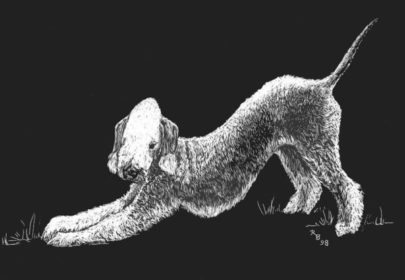
It was a Hungarian nobleman who gave us the first – and earliest – account of a terrier resembling the Bedlington Terrier. In 1702, Z. Molar visited Rothbury in the heart of Northumberland where Roma people (called gypsies in less politically correct times) camped in the forest. Molar wrote in his diary, “Today we hunted…on the way [home] we passed a gypsy encampment…These people had small Agar [Hungarian greyhound] like dogs with hair like that of a lamb. Lord Charles told me they were great dogs for hare and rabbit…”
Its arched back, lean body and long legs may have brought to Molar’s mind the build of a Greyhound, but the resemblance ended there. Molar went on to write that the Rothbury Terriers he saw during his visit to Lord Rothbury had the same physical characteristics. This was hardly surprising, in part because different breeds of terriers concentrated in Rothbury forest were collectively known as Rothbury terriers, but also because a specific breed of the lot was a favorite of Lord of Rothbury and came to be known as the Rothbury Terrier, or “Rothbury’s Lamb.” Though the breed could trace pedigrees back to 1782, it would be another 123 years before it got its modern name: Bedlington Terrier. The name is credited to the town in which Joseph Ainsley, a mason, had his dogs bred. The breedings ultimately produced Ainsley’s Piper, the first dog to be called a Bedlington Terrier, and a dog so game that despite missing teeth and being nearly blind, he was still dispatching otters at the age of fourteen.
Interestingly, the Bedlington Terrier Club of America mentions on its website that “some early ‘Bedlingtons’ had short legs, and these became known as Dandie Dinmont terriers. The longer legged dogs eventually were named the Bedlington Terrier.”
The Dandie Dinmont Club of America concurs – to a point. On its website, it writes, “Most experts agree that the Dandie Dinmont comes largely if not entirely from the same stock as the Border, Scottish, Cairn, West Highland White, Skye, Lakeland, Bedlington and Welsh Terriers, with some infusion of hound blood contributing to the shorter, crooked legs.”
All are in agreement that both breeds were developed to “go to ground” and hunt vermin and rodents with a zestful proclivity. Ancestral Bedlingtons were identified by a long muscular jaw, a narrow pointed head, a flatness of cheek, ribs that were flat and deep, and ears that hung close to the side of the head. They proved superior at catching rabbits, rats, marten, badger, fox, polecat and even otter. The Dandie, conversely, had to be neither too large and clumsy, nor too small and delicate, and equally endowed with strong jaws, a strong neck and a flexible body to perform the same task.
Image: Bedlington Terrier by Rachel Hames is available as fine art, home decor, and lifestyle items here.
